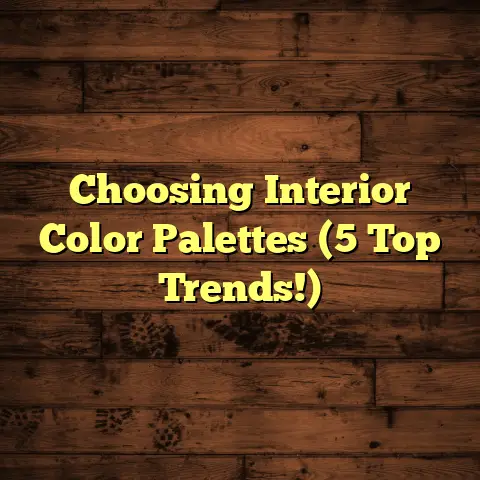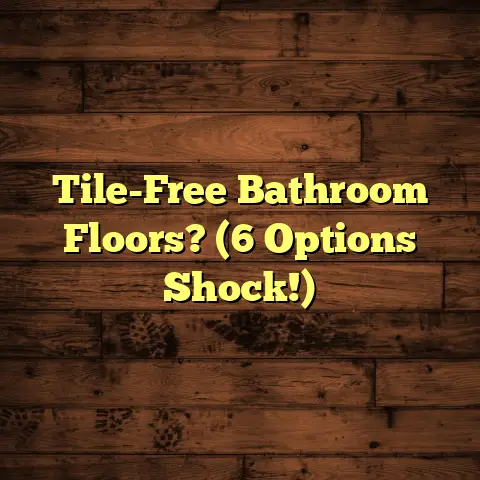Laminate Value Boost? (2 Factors, See ROI Now!)
I’m talking about flooring, specifically laminate. Now, I know what you might be thinking: “Laminate? Really?”
But trust me, laminate flooring has come a LONG way. It’s not your grandma’s cheap, shiny stuff anymore.
In fact, it’s become a seriously popular choice for homeowners and businesses alike. Why?
Because it’s affordable, versatile, and looks fantastic!
Over the years, I’ve seen laminate go from a budget-friendly option to a stylish and durable choice that can actually increase your property value.
We’re talking about a “value boost,” and that’s what I want to dive into today.
There are two main factors that, in my experience, make all the difference when it comes to getting the best return on your investment (ROI) with laminate flooring.
Ready to find out what they are? Let’s get started!
1. The Importance of Texture in Laminate Flooring
Okay, let’s talk texture. When most people think about laminate, they think about color and pattern.
But texture? That’s where the magic happens!
Defining Texture in Laminate Flooring
So, what do I mean by “texture?” Simply put, it’s the way the surface of the laminate feels.
Think about running your hand across a piece of wood – you can feel the grain, the knots, and the natural variations.
That’s what textured laminate aims to replicate.
We’re talking about things like:
-
Hand-Scraped: This gives the laminate a rustic, aged look with subtle variations in height and depth.
-
Embossed: This means the texture is pressed directly onto the laminate, matching the underlying pattern.
Think of it like feeling the wood grain pattern you see.
-
Embossed in Register (EIR): This is the creme de la creme of laminate texture.
The embossing precisely aligns with the image, creating an incredibly realistic look and feel.
-
Smooth Finishes: While not technically “textured,” smooth laminates have their place, especially in modern or minimalist designs.
But how does texture affect the overall look and feel of a space? It’s huge! Texture adds depth, character, and a sense of realism that flat, smooth laminate just can’t match.
It makes the floor feel warmer and more inviting.
Aesthetic Appeal and Market Demand
Why is textured laminate flooring so popular these days? Well, people want their homes to feel authentic and inviting.
They’re tired of sterile, cookie-cutter spaces. Texture adds visual interest and creates a more tactile experience.
It’s all about mimicking the look and feel of natural materials like hardwood or stone, without the high cost and maintenance.
Take a look at some of the hottest interior design trends right now:
-
Farmhouse Chic: Hand-scraped laminate is PERFECT for this style. It adds that rustic, cozy feel that everyone loves.
-
Modern Rustic: Combining clean lines with natural textures is incredibly popular.
Textured laminate fits right in!
-
Coastal Vibes: Light-colored, textured laminate can mimic the look of weathered driftwood, creating a relaxed, beachy atmosphere.
I’ve seen firsthand how much homeowners and designers love these options. They’re looking for ways to add character and warmth to a space, and textured laminate is a fantastic way to do it.
Functionality and Performance
Okay, so textured laminate looks great, but is it practical? Absolutely! In fact, texture can actually improve the functionality and performance of your flooring.
Here’s how:
-
Slip Resistance: Textured surfaces provide better traction than smooth surfaces, making them safer, especially in areas prone to moisture like kitchens and bathrooms.
-
Durability: While all laminate is pretty durable, textured laminate can actually help conceal scratches and dents.
The texture helps to break up the surface, making imperfections less noticeable.
Think about it: a tiny scratch on a smooth, shiny surface is going to stand out like a sore thumb.
But on a textured surface, it’s much more likely to blend in. This means your floor will look newer for longer!
Case Studies and Real-Life Examples
Let me tell you about a project I worked on a few years back. A homeowner in Austin, Texas, was looking to remodel their living room.
They wanted the look of hardwood, but were concerned about the cost and the potential for water damage (hello, Texas humidity!).
I recommended a high-quality, embossed-in-register laminate that mimicked the look of reclaimed oak.
The result was stunning! The texture added so much character to the room, and you honestly couldn’t tell it wasn’t real hardwood.
The homeowner was thrilled, and when they eventually sold the house, they told me the flooring was a major selling point.
I’ve seen similar situations time and time again.
Textured laminate can truly transform a space and add significant value to a property.
I remember another client with a bustling coffee shop.
They chose a textured, commercial-grade laminate that looked like distressed concrete.
It not only looked amazing, fitting perfectly with their industrial chic vibe, but it also held up incredibly well to the heavy foot traffic.
They haven’t had to replace it in five years, which is a testament to its durability and the value of choosing the right product.
2. The Role of Brand and Quality
Alright, now let’s talk about brand and quality. This is where things can get a little tricky, but it’s SO important to understand.
Understanding Brand Reputation
In the laminate flooring market, not all brands are created equal. Some brands have built a reputation for quality, durability, and innovation, while others… well, let’s just say they’re not quite as reliable.
Choosing a reputable brand can make a HUGE difference in the long run. Why? Because brand recognition influences consumer decisions and perceived value.
Think about it: when you see a well-known brand, you automatically associate it with certain qualities, like reliability, performance, and customer service.
This can give you peace of mind knowing you’re investing in a product that’s built to last.
Quality vs. Cost
Now, I know what you’re thinking: “But the cheaper stuff looks the same!” And sometimes, it might.
But trust me, the difference in quality is HUGE.
Investing in high-quality laminate can lead to lower maintenance costs and increased property value.
Here’s why:
-
Durability: High-quality laminate is more resistant to scratches, dents, and stains.
This means it will look newer for longer and require less frequent replacement.
-
Water Resistance: Some high-end laminates are even waterproof, making them ideal for kitchens, bathrooms, and basements.
-
Installation: Quality laminate is typically easier to install, which can save you money on labor costs.
-
Longevity: A cheap laminate might last 5-7 years, while a high-quality laminate can easily last 15-20 years or more.
So, while you might save a few bucks upfront by going with the cheaper option, you’ll likely end up paying more in the long run due to repairs, replacements, and decreased property value.
Speaking of quality, don’t underestimate the importance of certifications and warranties.
Certifications like FloorScore® ensure that the laminate meets strict indoor air quality standards, which is important for your health and the environment.
Warranties protect you against manufacturing defects and premature wear and tear.
Look for laminates with long warranties (25 years or more) to ensure you’re getting a product that’s built to last.
Comparative Analysis of Brands
Okay, let’s get down to specifics. Here’s a quick look at some of the leading laminate flooring brands and what makes them stand out:
| Brand | Unique Selling Proposition | Quality | Customer Satisfaction |
|---|---|---|---|
| Pergo | Known for inventing laminate flooring, Pergo offers exceptional durability and water resistance. | High | Generally high, especially for their premium lines. |
| Mohawk | Offers a wide range of styles and price points, with a focus on innovation and sustainability. | Varies depending on the line, but generally good. | Good, with a wide range of options to suit different budgets. |
| Shaw Floors | Known for their realistic wood and stone looks, Shaw offers a variety of textured laminates with excellent visual appeal. | Good to very good. | Good, particularly for their style and design options. |
| Armstrong | Offers a range of affordable and durable laminates, with a focus on easy installation. | Good for the price point. | Generally positive, especially for DIY installations. |
| Mannington | Known for their high-end, realistic designs and innovative technologies, Mannington offers some of the most beautiful laminates on the market. | Very high. | High, but may be more expensive than other brands. |
| Tarkett | Strong focus on sustainability and eco-friendly materials, Tarkett offers a range of durable and stylish laminates. | Good to very good. | Good, especially for environmentally conscious consumers. |
Disclaimer: This table provides a general overview based on my experience and publicly available information. Customer satisfaction can vary, and it’s always a good idea to do your own research and read reviews before making a purchase.
The best brand for you will depend on your specific needs, budget, and aesthetic preferences.
I always recommend visiting a flooring showroom to see and feel the different options in person.
Talk to a flooring professional (like me!) to get personalized recommendations based on your project.
3. ROI and Market Trends
Okay, we’ve covered texture and quality. Now, let’s talk about the bottom line: ROI (Return on Investment).
Calculating ROI for Laminate Flooring
How do you calculate the return on investment for laminate flooring? Well, it’s not as simple as adding up the cost and comparing it to the sale price of your home.
You need to consider a few factors:
-
Initial Cost: This includes the cost of the flooring itself, underlayment, and installation (if you’re not doing it yourself).
-
Maintenance Costs: Laminate is relatively low-maintenance, but you’ll still need to factor in the cost of cleaning supplies and occasional repairs.
-
Increased Property Value: This is the tricky part. It’s hard to say exactly how much laminate flooring will increase your home’s value, but it can definitely make a difference.
A well-chosen, high-quality laminate can make your home more attractive to potential buyers and help you sell it faster and for a higher price.
-
Energy Savings: Laminate flooring can help insulate your home, reducing your energy bills.
This is a small but significant benefit that can add up over time.
So, how do you put it all together? Here’s a simple formula:
(Increased Property Value + Energy Savings – Initial Cost – Maintenance Costs) / Initial Cost = ROI
Let’s say you spend $5,000 on laminate flooring and installation. Over the next 10 years, you save $500 on energy bills and spend $200 on cleaning supplies.
When you sell your home, it appraises for $7,000 more than it would have without the new flooring.
Your ROI would be:
($7,000 + $500 – $5,000 – $200) / $5,000 = 0.46 or 46%
That’s a pretty good return!
Of course, this is just a simplified example. The actual ROI will vary depending on your specific circumstances.
However, it illustrates the potential for laminate flooring to be a smart investment.
According to a 2023 report by Remodeling Magazine, the national average cost to install laminate flooring is around $4,800, with an estimated resale value increase of around $3,500, resulting in a cost recouped of approximately 73%.
This means that for every dollar you spend on laminate flooring, you can expect to recoup about 73 cents when you sell your home.
Current Market Trends
What’s hot in the world of laminate flooring right now? Here are a few trends I’m seeing:
-
Eco-Friendly Materials: Consumers are increasingly looking for sustainable and environmentally friendly products.
Laminates made from recycled materials or with low VOC emissions are becoming more popular.
-
Waterproof Laminate: As I mentioned earlier, waterproof laminate is a game-changer.
It’s perfect for kitchens, bathrooms, and basements, and it gives homeowners peace of mind knowing their floors are protected from moisture damage.
-
Wide Planks: Wide plank laminate flooring is trending because it creates a more spacious and luxurious feel.
-
Realistic Textures: Advances in technology have made it possible to create laminates with incredibly realistic textures that mimic the look and feel of natural wood and stone.
Future Outlook for Laminate Flooring
What does the future hold for laminate flooring? I think we’ll see even more innovation in terms of design, durability, and sustainability.
Here are a few predictions:
-
Even More Realistic Textures: Expect to see even more advanced embossing techniques that create laminates that are virtually indistinguishable from natural materials.
-
Improved Water Resistance: Waterproof laminate will become even more common and affordable.
-
Smart Flooring: Imagine laminate flooring that can monitor your home’s temperature, humidity, and even detect leaks!
This technology is still in its early stages, but I think we’ll see it become more prevalent in the coming years.
-
Customizable Designs: Advances in digital printing will make it possible to create custom laminate designs that perfectly match your personal style.
The laminate flooring market is constantly evolving, and I’m excited to see what the future holds.
Conclusion
So, there you have it! The two key factors that can significantly boost the value of laminate flooring: texture and quality/brand.
By understanding these factors, you can make informed decisions and choose laminate flooring that not only looks great but also provides a solid return on investment.
Remember, it’s not just about saving money upfront. It’s about investing in a product that will last for years to come, increase your property value, and make your home a more enjoyable place to live.
Whether you’re a homeowner, real estate investor, or designer, I encourage you to consider these elements when choosing laminate flooring.
Do your research, talk to a professional, and choose a product that meets your specific needs and budget.
With the right approach, you can achieve the best possible ROI for your property and enjoy the beauty and durability of laminate flooring for years to come.
Happy flooring!





